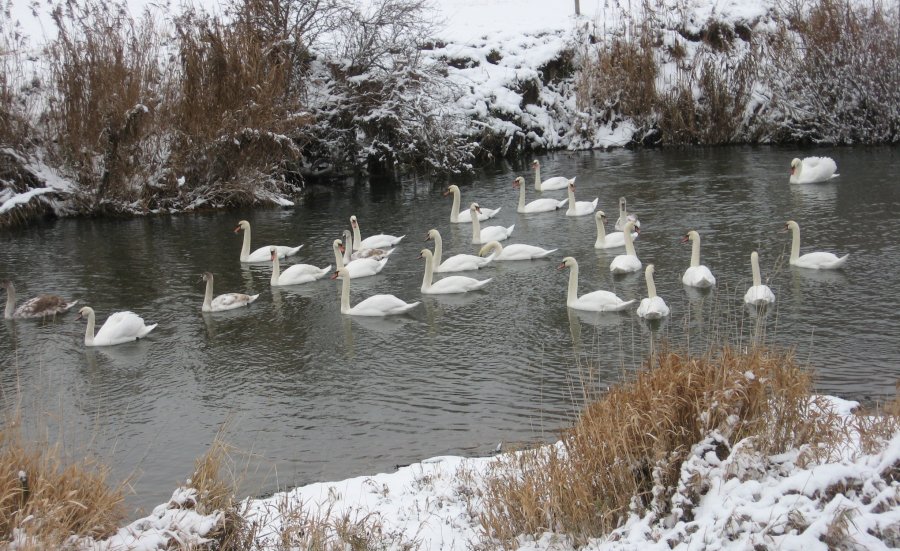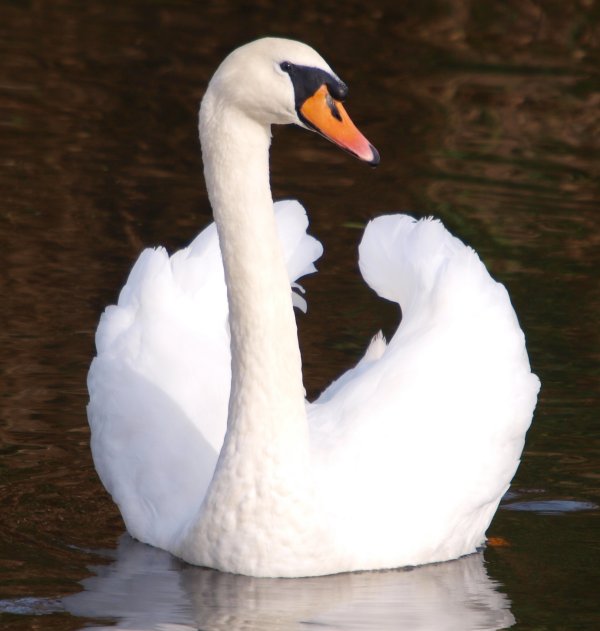Updated 29 Oct 2014
|
Swan KUB at Bear Mead
|
|
Swan KUB on the Stour at Bear Mead
|
This webpage is to commemorate the life of a mute swan
identified as KUB. He spent most of his life on the Dorset
Stour near Bear Mead, just upstream of Wimborne Minster.
His presence, habits, mates and offspring were recorded
by  , who built this webpage. All the photos
were taken by Paul Wickins or Alan Jones
(except this and
this which were taken by the webmaster).
See records of KUB and first wife and
emails about swans on the Stour , who built this webpage. All the photos
were taken by Paul Wickins or Alan Jones
(except this and
this which were taken by the webmaster).
See records of KUB and first wife and
emails about swans on the Stour
See BTO web site www.bto.org/about-birds/birdfacts
|
Mute Swan Breeding.
"The male and the female birds, the cob and pen, usually attempt to
mate for life, although it is not true to say that if one of the birds
were to die the other would necessarily pine away. It is possible for
an adult bird to find an alternative mate.
The nest is a huge mound of material, normally dried grasses and assorted
vegetation, sticks and rushes, constructed at the water's edge. The nest
is built by the female, while the male supplies the materials.
The female lays up to seven eggs between late April and early May. Both
sexes incubate the eggs, which hatch after 35-41 days. The young birds,
or cygnets, sometimes ride on their parents' backs and remain with the
adult birds for four or five months. Cygnets are generally dingy brown
above and whitish below. Occasionally' cygnets may be all white and are
known as 'Polish swans'.
The young of some pairs are driven off the breeding territory as soon as
their plumage is predominantly white (during late autumn or winter). Other
broods often accompany their parents to the wintering area, and usually
join a large flock in which they remain when the parents return to their
breeding territory. Young birds will not generally breed for the first
two years of adult life.
The oldest ringed wild mute swan was 15 years old."
(27 years acc.to BTO).
From
RSPB.org.uk
|
Year
cygnets |
2004
4 |
2005
12 |
2006
4 |
2007
7 |
2008
7 |
2009
6 |
2010
6 |
2011
0 |
2012
2 |
2013
7 |
2014
6 |
Total
61 |
6099.
Hello, I'm KUB, a male Mute swan (Cygnus oler), born in 1997
(or earlier).
The top of my head is stained orange-brown by irons and tanins in the water.
I have a large knob above my bill and my bill is deeper orange than my wife's.
I'm not really mute, but can hiss and make funny little growls.
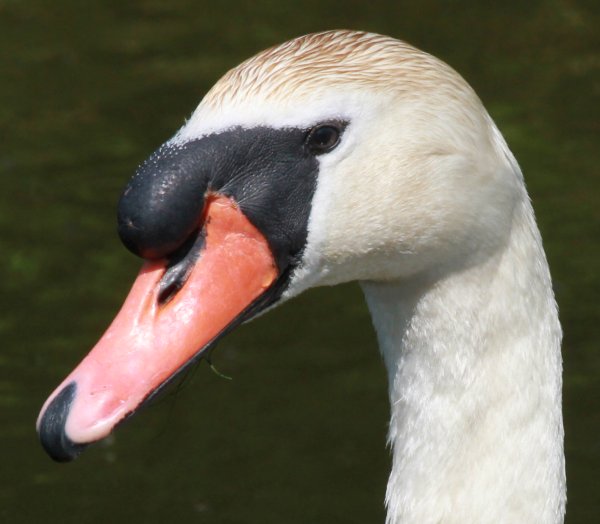 |
6004.
I'm a big bird, one of the heaviest flying in the country.
They say I weigh 26-30 lbs. My wingspan is nearly 8 feet.
The whining sound of my big feathers as I fly is unforgetable.
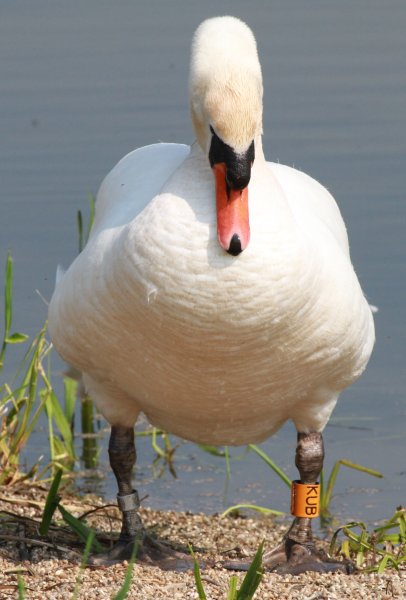 |
6129.
I eat waterweed growing on the bottom of the river. I also like
grazing the grass on the fields by the side of the river Stour.
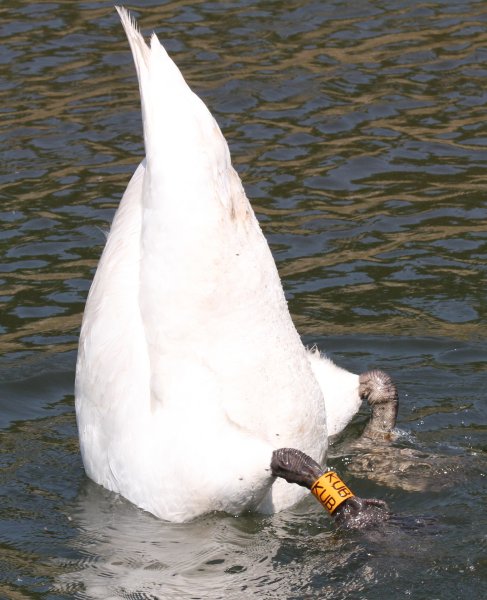 |
6055.
When I feel relaxed, I can rest my leg on my back like this.
This makes it very easy for the cameraman to read my orange
leg-band, and tell who I am (because most swans look the same,
don't they!).
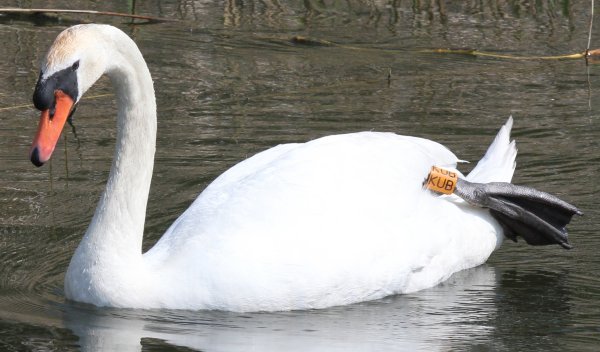 |
darvic.
This leg-band or Darvic was placed on my leg in 1998
and 1 year old. Fifteen years later, I'm surprised
it is still so shiny
Alan Jones
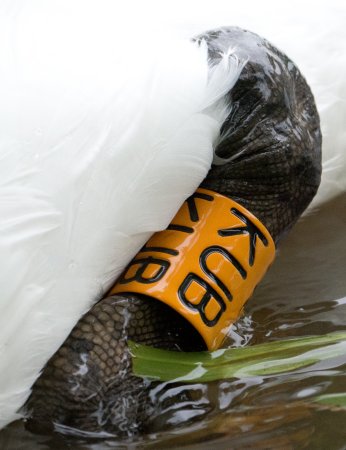 |
KUBpreen.
I've got a lot of big feathers, and these need looking
after. A lot of my time is spent preening.
Alan Jones
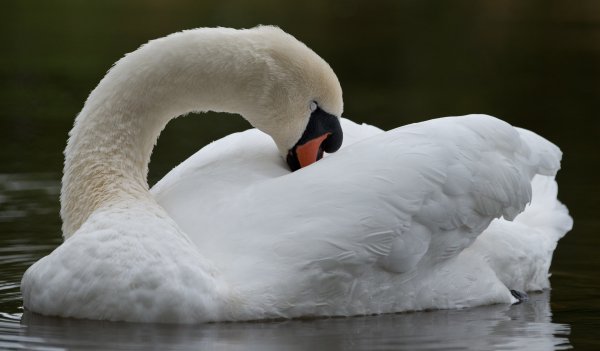 |
6017.
My wife and I spend a lot of time grooming ourselves.
We each have an awful lot of feathers, and they all need
to be kept straight and tidy. This is where a long neck
comes in handy.
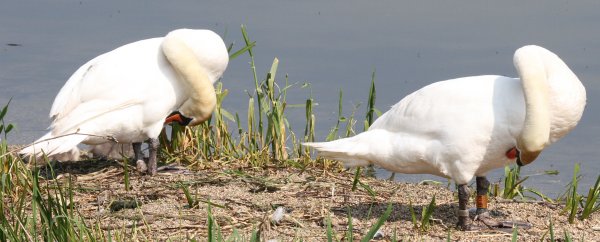 |
SWANS-2.
I'm strongly territorial. Here I'm chasing away 25 young swans who
were 'socialising' on my favourite patch of river at Bear Mead on the
Dorset Stour.
I've become habituated and fearless towards humans, but
don't get too close when I have cygnets. That includes canoes!
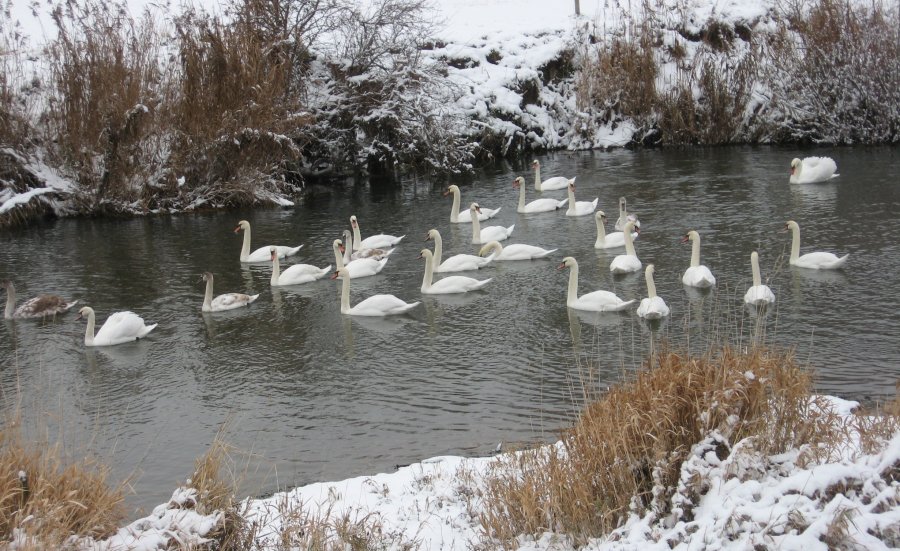 |
5944.
Usually my neck is straight, and my darvic (orange leg ring)
is on my left leg
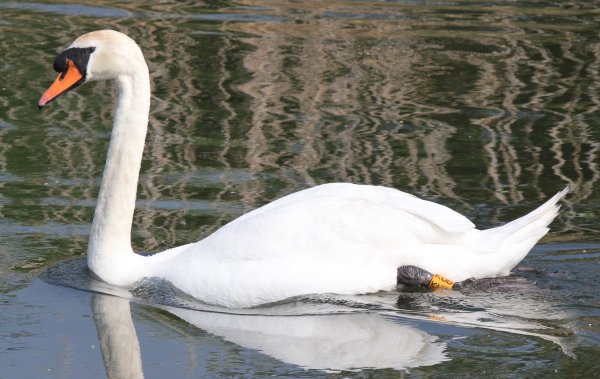 |
5994.
Being a male (a cob) I have an especially large knob above my beak,
and the bill is a darker shade of orange than a pen.
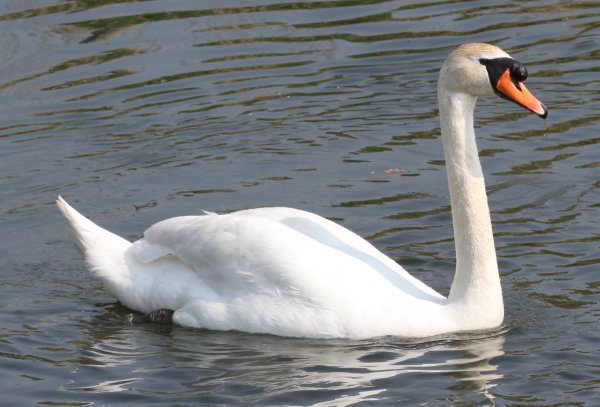 |
6014.
I'm monogamous, and stay with the same wife for many years.
Sadly my first wife (KNC) died in care in 2006, after we'd raised over 16
cygnets. But I got myself a new wife that year and we've raised 32 since.
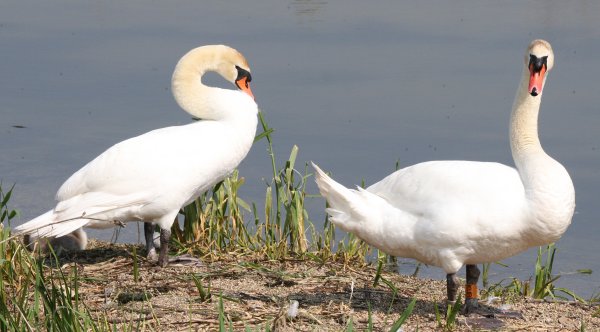 |
3166.
In 2011, for the first time, we had no cygnets. Maybe I'm getting old.
In 2012 we only had two. We look after our young very well.
Here my wife and I are getting annoyed at the cameraman,
and arching our wings to show it. This threat display is called "busking".
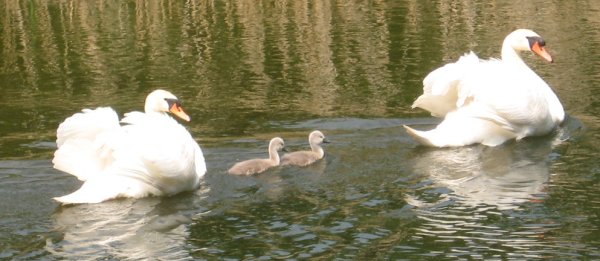 |
PW-1.
I'm a beautiful bird. Poets and composers have celebrated my elegance.
They say, just before I die, I sing my only song, known as
a swan song!
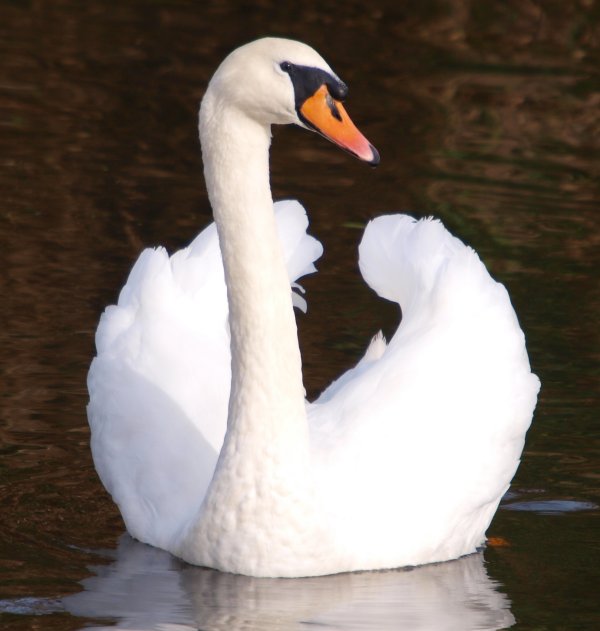 |
3497.
In 2013 my mate and I raised 7 cygnets, but lost 2 when they
were still very small (perhaps eaten by pike?)
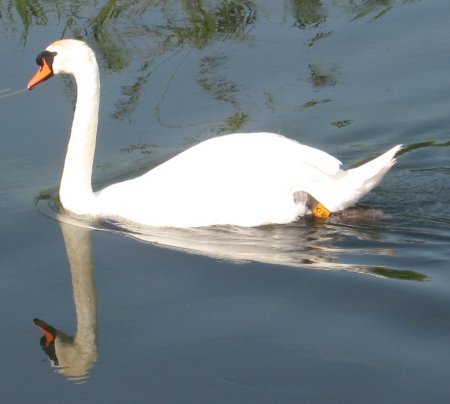 |
9001.
Here's my mate Kay in 2014 with our 6 new cygnets.
They were hatched on 14 May, on a large hidden nest
1km from the river. On the 16 May we'd all reached
the Dorset Stour
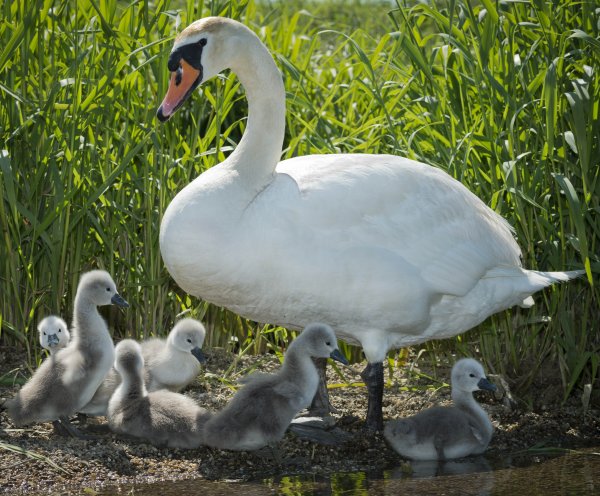 |
9002.
I'm proud of my new cygnet, hatched 14 May 2014 after 36 days
incubating.
It feeds itself and should be flying in 6 months
time.
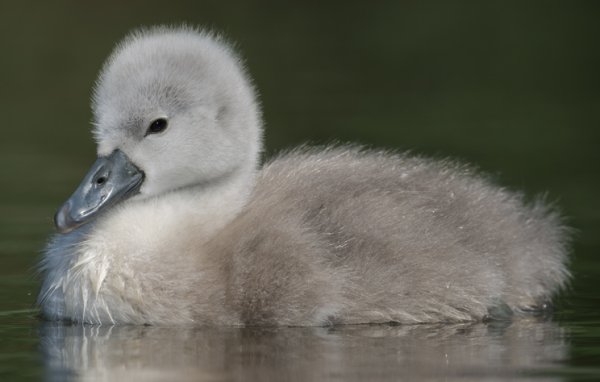 |
3739.
How Alan Jones takes such good photos. He habituates
KUB and family by dressing in waders and camouflage gear and
spending many hours among them from sunrise. With a big camera
and lens he can photo eyelashes! This is a favourite spot for
KUB and family, its autumn and the river is very low, exposing
a convenient beach and shoal, ideal for snoozing. As KUB gets
older he spends more time having a snooze, like an old man.
Just look how the cygnets have grown in 19 weeks!
27sep2014
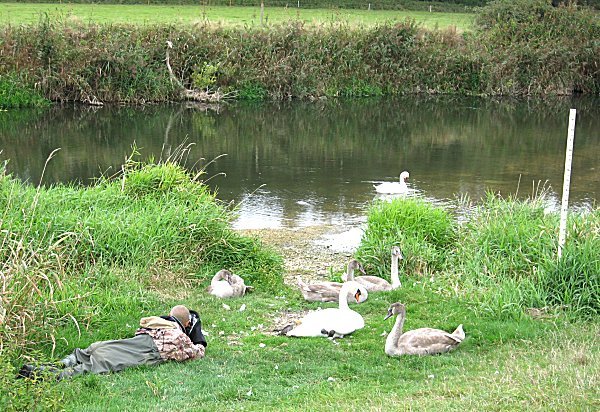
3738..14sep2014
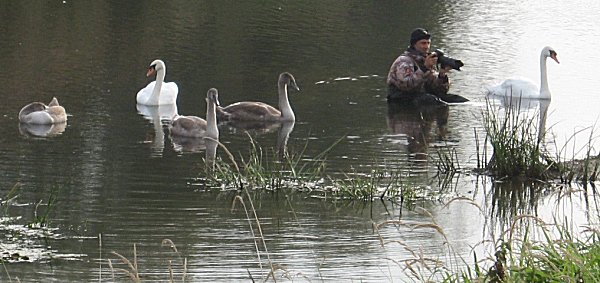
|
map.
My mate and I usually build our nest in April
away from the river (which might flood). Instead we
choose an Old Mill Stream in a lonely part of Eye Mead.
One of us is on the nest, the other sits nearby on guard.
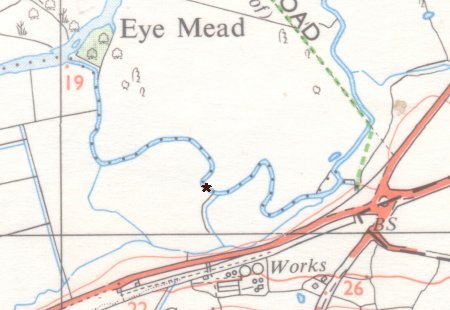
|
3663.
KUB's mate on the nest, the Old Mill Stream 10apr2014.
Well built, well hidden, surrounded by reeds, the Mill Stream
is on a wide flood plain and doesn't rise much should there be a flood.
Hatched 14may2014.
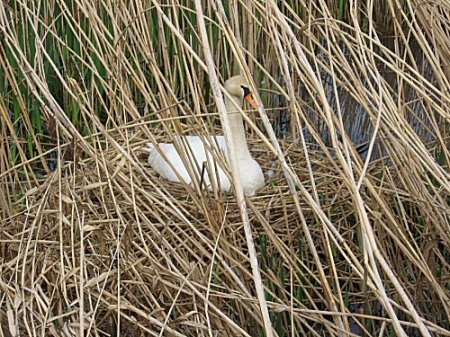
|
KUBinj1.
Alas, on 18oct2014 I fought for - and lost -
territory to a younger
swan, sustaining an injury just below my left eye.
This has shaken me considerably, as I'm 16 years old now.
But, on 25oct2014 I was in my usual snoozing spot
below the Hut, with no visible sign of a wound, and looking very well
groomed and clean
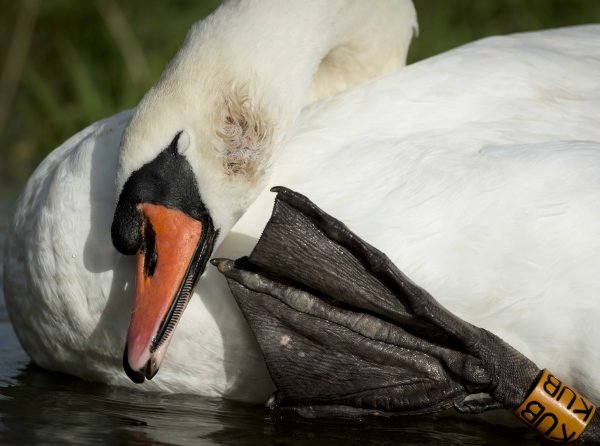 |
9000
Taken by Alan Jones, who writes: "It was taken this Monday,
27oct2014,
during the afternoon. I'd just arrived, but he was a couple of hundred
metres downstream, so I called him and he paddled his way towards me.
When he arrived at the bankside just below the hut, he scrambled out of
the water and started to make his way up the bank towards the top. Seeing
how keen he was and the direction of the wind (into his front side
facilitating 'flying'), I had the camera ready and managed
to get the image I sent you.
We then sat down together and had a picnic and had a discussion about how
wonderful he is and how you and I look forward to seeing him and have a
great deal of respect for him. He agreed with our sentiments and tucked
into his afternoon food. At the end, we both had a snooze together
before we were both woken up by a fisherman walking past. He really is
a wonderful swan and I think he's as keen on us as we are on him!"
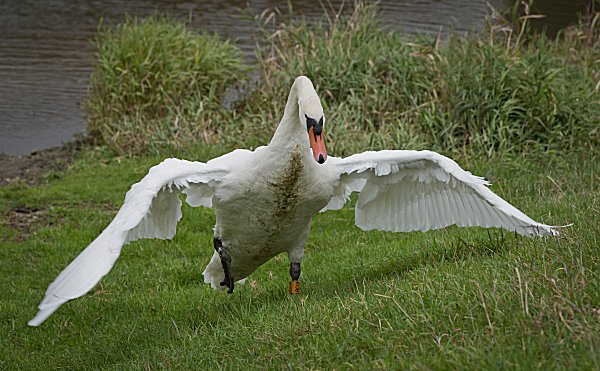 |
N=newly ringed, X=dead, BTO gives the number of the metal ring on the opposite leg to the plastic ring.
Age 5 = first year, Age 6 = adult
RTYPE BTO Darvic Age Sex Date Place Site Status Mate Notes
------------------------------------------------------------------------
N X1957 KNC 6 18-Jul-99 Christchurch Harbour group
KNC 11-Jun-04 Cowgrove Wimborne Pr+4 KUB
KNC 29-May-05 Cowgrove Wimborne
KNC 11-Jun-05 Cowgrove Wimborne Pr+12 KUB
X X1957 KNC 19-Jun-06 Holt Heath Died in care
------------------------------------------------------------------------
N X3104 KUB 6 18-Jul-99 Christchurch Harbour group
KUB 11-Jun-04 Cowgrove Wimborne Pr+4 KNC
KUB 29-May-05 Cowgrove Wimborne
KUB 11-Jun-05 Cowgrove Wimborne Pr+12 KNC
KUB 15-Jul-06 Cowgrove Wimborne Pr+4
KUB 15-Jun-07 Cowgrove Wimborne Pr+7 no darvic
KUB 29-Jun-08 Cowgrove Wimborne Pr+7 no darvic
KUB 23-Jul-08 Cowgrove Wimborne Pr+6 Cygnet lost in floods
KUB 10-Jan-09 Cowgrove Wimborne Pr+6 no darvik
KUB 25-May-10 Cowgrove Wimborne Pr+6 no darvik
KUB 02-Jun-11 Cowgrove Wimborne Pr+none no darvik, no cygnets
KUB 20-May-12 Cowgrove Wimborne Pr+2 no darvik
KUB 24-May-13 Cowgrove Wimborne Pr+7 no darvik
KUB 26-May-13 Cowgrove Wimborne Pr+5 no darvik, 2 cygnets never seen again
KUB 14-May-14 Luther Wimborne Pr+7 no darvik, 6 eggs hatch on Mill Stream
KUB 17-May-14 Cowgrove Wimborne Pr+6 no darvik, at Bearmead
KUB 28-May-14 Cowgrove Wimborne Pr+5 no darvik, 1 cygnet never seen again
------------------------------------------------------------------------
|
|
----Anyone with more details for publication on this webpage,
please email  ---- ----
------------------------
Dave Stone wrote 17jun2014
Hello John
I had meant to mention H8V/J3N in my earlier email. I have no information
on J3N beyond your last sighting on 12/05/11. He may well be the male you
saw this year with H8V but had simply lost its Darvic ring. It would be
interesting if you could spot whether the male has a metal ring or not. I
notice on your website you have listed the sighting history of J8N but not
of H8V. Obviously most of the sightings of the pair will be on the same
dates but if you want the early records for H8V - she was ringed as an adult
on 16/07/06. You had sightings, with J3N, in May 2007 but she was back in
Christchurch harbour on 27/07/07 and 20/07/08. The behaviour of the pair
suggests they were looking for a territory in the early years and not being
successful returned to Christchurch to moult. After 2008, when their visits
to Christchurch ceased, they may well have remained in your area and taken
up territory somewhere in the vicinity.
Regards
Dave
------------------------
David Stone wrote on 17jun2014
Hi John
Many thanks for your emails updating me on this year's nesting of KUB. I
hope the 6 cygnets are still doing well. Over the years he has certainly
been a prolific bird - what we would call an alpha male. In most swan
studies it is usually a few pairs that contribute most cygnets to the
population and the others are either unsuccessful or fail to rear many
cygnets.
I expect Alan Jones has mentioned that I was able to give him some
sighting histories of the ringed birds he has come across. His photographic
study of KUB and mate must have been an absorbing project.
On the Avon and Wylye it has been an odd breeding season in that in April
some pairs were nesting as usual but others were well behind expected
timings. This may well be due to disruption by the over winter floods as
feeding opportunities were reduced by flooded meadows and slow recovery of
water weed in the Spring after the floods either buried weed beds in silt
and gravel or swept other beds away. It will be some time before I get the
full picture of breeding success up and down the valley.
Regards
David
-------------------------
Dave Stone wrote on 16nov2013
Hello John
Its good to hear that KUB fledged 5 cygnets after the early loss of 2. Good
too that you now know the nest site. I will try and arrange a visit in
April and see if we can get the female ringed.
I don't know where the RSPB get their data from but the best source of
longevity based on ringing is on the BTO web site www.bto.org/about-birds/birdfacts
The record for a mute swan is 27 yrs 6
m 27 days set in 2010 in Derbyshire. The BTO data is recorded as the
elapsed time from ringing rather than actual age, as many are ringed as
adults. The record holder, however, is known to have been hatched a year
priors to ringing. In my study area I have had two birds get to 26 years
(and still breeding when they went missing) and a few at 25, which included
one near you in Wimborne on the Allen.
Regards
David
-------------------------
David Stone wrote on 21may2013
Hi John
Good to hear that KUB is still going strong and, so far, is having a good
season. While spring is supposedly late this year, the swans certainly
haven't noticed and are on schedule. I was in the Avon valley late
Apr/early May and found good numbers nesting. If there are no late floods
or prolonged cold weather then it should be a bumper season for cygnets.
I'm afraid I have no additional data on KUB but I notice on the KUB webpage
that you say he was born in 1998. This is not strictly correct. As he was
ringed as an adult in 1999, we don't know his exact age. If he had been
born in 1998 he would have been recorded as a first-year bird when ringed,
so he must have been born in 1997 or earlier.
Do you still get a wintering flock or is KUB keeping all others away?
On 20 July this year there will be the biannual round up of swans at
Abbotsbury. Helpers are always welcome if your interested.
Regards
Dave
-------------------------
David Stone wrote on 03jul2012
Hi John
Many thanks for the update on KUB and SUF. You say in your email that KUB
hasn't been seen this year but on your website you show an entry for him on
20 May 12 with 2 cygnets?? SUF has not been so regular at Bear Mead, so it
is possible that because of the territorial presence of KUB it hasn't been
able to take up a suitable nest site. If KUB has now left it will be
interesting to see if SUF does stay to breed. Because of the high swan
population in the area there are always some birds that never seem to take
up territory and breed but certainly infertile pairs, and even gay pairs, do
exist.
When I was in my study area in Apr/May it was clear that swans were having a
difficult breeding season. On the chalk streams above Salisbury water levels
and flow rates were very low when I arrived and the river bed was almost
devoid of waterweed. A number of regular pairs appeared not to have come
into breeding condition but had remained on territory and were still grazing
in neighbouring fields. By the time I had moved below Salisbury the river
was in flood and many nests had been washed out. I imagine the same thing
happened on the Stour. I haven't yet been in the area to see whether birds
have renested - if not then productivity this year will be very poor.
Best wishes
David
-----------------------------------
|
|
Compiled, formatted, hyperlinked, encoded,
and copyright © 2012, John Palmer,  All Rights Reserved. All Rights Reserved.
|







